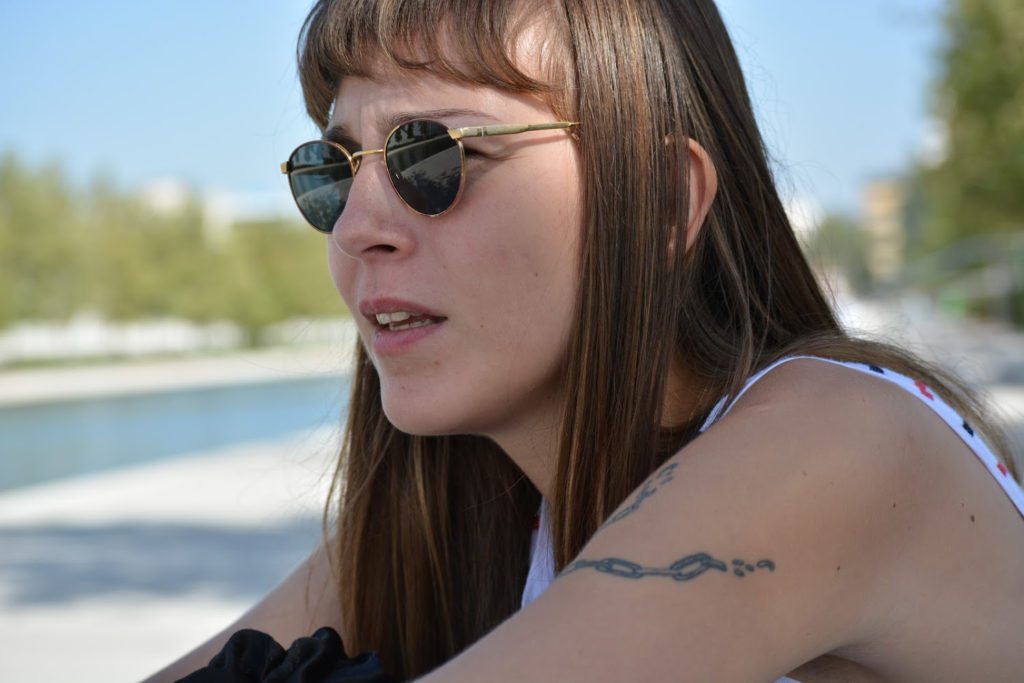Learn about what others have chosen to study and do through this innovative program.
Kimberly Davis graduated from York University with a specialized honors Bachelor of Arts Degree in Digital Media. She has worked as a student ambassador and mentor for the Digital Media program, and at the Art Gallery of York University (AGYU) assisting artists with technical aspects to their artworks. She has also worked with other independent artists as a professional assistant and tech artist.
Kimberly’s research interests involve interactive installations, data visualization, mixed reality, and user interfaces. She hopes to expand her knowledge of these areas while also exploring the possibilities of what can be created. One of Kimberly’s most recent projects is a capstone project called “Hi Glitchi :).” This research-based project explores the use of artificial intelligence in a quirky format to create an unconventional relationship between a flower and a human using the Twitter platform. This relationship has been inspired by the book “The Secret Life of Plants,” written by Peter Tompkins. In this book, it is said that plants are living creatures categorized as blind, deaf, and dumb compared to humans, but Glitchi is quite the opposite because he has his own voice to communicate. Participants are able to communicate with this “extraterrestrial” flower triggering unexpected responses based on users’ questions through the use of speech recognition, petal movement, lights, Tweets, along with Twitter Sentiment Analysis.
Douglas Gregory (he/him/his) is a game designer and educator, with 14 years of experience developing commercial video games at both indie and AAA scale. From 2011-2021, Douglas worked at Ubisoft Toronto, contributing to Splinter Cell: Blacklist, Starlink: Battle for Atlas, and Far Cry 6.
Since 2017, Douglas has also taught part-time in the Bachelor of Game Design program at Sheridan College, covering areas including game mechanics, systems design, game economies, balancing, and uses of data in design. He also serves as an elected community moderator on GameDev.StackExchange, helping fellow developers solve design and technical problems that arise in game development.
Douglas is pursuing research into uses of procedural generation in game development, including runtime generation of new environments or mission objectives, and its use as a tool for developers authoring game content with algorithmic acceleration or mixed initiative collaboration with the machine.
One of his most recent projects was created at a 3-day TOJam in 2021. That's My Jam is a freestyling rhythm game where players improvise their moves on the fly. Pressing buttons to the beat drives a procedurally-generated dance to be performed by the on-screen dancers, while the player is scored for their timing accuracy.
With a BA in Theatre and Digital Media, Kwame explores the interdisciplinary nature of digital media at the intersection of performance and computational art. He is interested in exploring the body as a medium for human-computer interaction, connecting the physical to the digital in performance and interactive settings. As someone with a background in devised theatre, he enjoys work that is performative and dynamic and leans toward the abstract and the metaphorical, leaving more room for play and experimentation. Coming from the world of theatre, he also brings an eye for storytelling and narrative.
His most recent project, Kaleidoscope Dreams uses Facemesh, a program that tracks the user's face, creating a surreal virtual mask on a screen. Fluttering about in the environment are butterflies. If the user closes their eyes, the butterflies are drawn to the user’s third eye of the virtual mask. When the butterflies get close enough to the third eye, and if the user opens their mouth, a synth triangle wave is produced and the butterflies go through a metamorphosis, becoming more ethereal, kaleidoscopic and free in their movements. This project was inspired by the mythology surrounding butterflies, in which some cultures view them as a representation of the soul, of rebirth, or of death, as well as the third eye, which in many cultures symbolizes a state of enlightenment. The title is derived from the official name of a group of butterflies, a kaleidoscope, as well as from the Chinese philosopher Zhuangzi, who once woke up from a dream in which he was a butterfly and thought “Am I a man who dreamt of being a butterfly, or am I a butterfly dreaming that I am a man?”
Zhouyang Lu is a creative, innovative, and passionate Chinese digital media designer also with experience in graphic designing engaging logos, posters, web pages, app UI, brochures, promotional videos, etc. At the same time, he has experience in 3d modelling and physical installation art. After his BA in Digital Media at York University, he has commenced graduate studies, pursuing an MA in Digital Media and focusing on the intersection of Design, interactive technologies and Data visualization. He is currently exploring intersections of visual and print media, and formats of interactive installations.
BREATHE: A COVID-19 Data Visualization Design
The Coronavirus Disease 2019 (COVID-19) is indeed one of the most significant pandemics in history. Even though this is an ongoing situation, this pandemic offers a wide array of data that might be difficult for ordinary, non-scientific people to understand. This topic is relevant nowadays, and people need to be educated regarding the intensity of this pandemic; this can be done by creating emotions using a data visualization installation. The researcher also finds this topic as a good theme for this research project because it aims to remind people of the first anniversary of this pandemic and how it has spread at a terrible rate.
While this pandemic was surfacing throughout the world, the researcher made numerous designs that visualize the virus and its implications. Hence, choosing this issue as the central theme of this research can gather together differing audiences and opinions. Moreover, the wide range of data about COVID-19 overwhelms people—the main reason why people are still not knowledgeable regarding the dangers of this pandemic, resulting in people preferring to not wear masks and to be disobedient to social distancing guidelines. By applying the concept of data visualization, the large datasets regarding this pandemic can be easily explained and, hence, understood by the general audience.Close
Jonathan Silveira is a media artist from Toronto, Ontario with a Bdes from OCAD University in Graphic Design. Jonathan has experience in graphic design, motion capture and creative coding in interactive media. Jonathan is a member of The Public Visualization Lab (PVL), a cross-institutional research lab with members at York, OCAD and Ryerson Universities. His work at the PVL has been in the production of content and tools for artists, designers, and communities for public installations and exhibitions such as Everything In Its Place, 2017 (Reel Asian Film Festival, Toronto.), Diagrams of Power, 2018 (Onsite Gallery, Toronto), Passing Through the Heart, 2020 (ISEA International conference) and Nuit Live: Online Archive Activation, 2020 (Nuit Blanche, Toronto).
Jonathan’s research interest is in exploring the intersection of narrative, game engines, cinematics, and interactive immersive productions. His major research project at York University investigates the use of game engines to model complex behaviours in artificial life ecosystems. The project leverages generative ontologies, game design, and storytelling to explore the dynamics of resource distribution on entities inside an ecosystem. This work was inspired by the role of algorithms in the emergence of radicalization, conspiracy theories and anti-scientific rhetoric on social media networks. The theoretical framework that guides this project was developed using cybernetics, to analyze the effect of a system whose actions are fed back into its self to steer its future behaviour, and symbolic interactionism to investigate the individual’s micro-level actions with each other that evolve into their society. This project follows the research-creation methodology situated in the fields of computational and generative arts.
Hrysovalanti Fereniki Maheras is a PhD student in Digital Media at York University and she is studying with Dr. Mark-David Hosale as a researcher at nD::StudioLab. She holds a B.A. Hons in Media Arts from Plymouth University, UK and an M.A. in Digital Media from York University, CA. In her research, she speculates on the innovation of computational machines as emotional beings, as she navigates the connections between the philosophical theories written about the human soul, and the cybernetic theories and artworks created for the exploration of the mind of technology. Her practice emphasizes on the creation of groups of electronic sound/kinetic sculptures that act as artificially living communities. Traversing both virtual and physical worlds, she explores the creation of a virtual analog environment emerging in a shared complex physical habitat.
THUMOS: Synthesis of Artificial Emotions in Interactive Sculptures
Thumos is an artwork made of an array of five free-standing interactive sculptures. The word thumos, or spiritual Eros, is an ancient Greek word used by Plato in his book The Symposium to describe the part of the human soul that translates to the whole of emotions. I am influenced by Plato’s approach to the study of the human soul as an analogy for understanding the mind and desire of the future of the computing machine by preconceiving the rise of mechanical beings, and speculating on what they could be. The process of the creation of the artwork Thumos follows a research-creation methodology that focuses on the attunement of natural and artificial organisms in a digitally modulated physical habitat. In the Thumos habitat, a community of synthetically emotive sculptures negotiate the transference of artificial emotional states through stochastic dialogues. The dialogues unfold in a charged environment, where the simulated desires and thoughts of the sculptures generate light and sound events. My effort has been to incorporate the capacity of humans to entrain their emotions towards positively charged emotional states in an interactive installation that invites people to co-create with the synthetically emotive sculptures the experience of the Thumos installation. It is in this spirit that my work uses a speculative approach to create an alternative eco-systemic framework for art making based on cybernetic theories and philosophy as its basis.
Rory Hoy is a PhD student in Digital Media, and a researcher in the DisPerSion Lab at York University. His work is aimed at the crossroads between sonic ecosystems, agent simulation, networked music, and human/machine collaboration. Exploring the musical potential of artificial life systems, his work places performers as equals with virtual beings inspired by natural processes to investigate resulting perceptual and performative outcomes of their interplay. Rory holds both an MA and BA Hons in Digital Media from York University.
Locus Diffuse
Locus Diffuse is a networked multi-user instrument populated by a simulated slime mold and four human players. Mimicking the biological behaviour of slime mould and establishing a virtual living network between player nodes, the system sonifies interaction along these connections. Stigmergy resulting from distributed participant positions and autonomous agent sensing/signalling results in a collaborative sonic environment facilitating the social ritual of musical play. Participants use a browser-based interface to play the multi-user instrument, and access an accompanying stream for audio and visual output of the system. Player responses from various play sessions are explored and reported in relation to emergent narratives, reflections on the sense of self within the established collective, various visual and aural perspectives, characterization of four experienced environmental states, and natural metaphors for behaviour of the system.

Learn More
The Graduate Program in Digital Media at York is an exciting environment to pursue innovative, socially engaging, career-ready education. Contact our Graduate Program Assistant to learn more.


